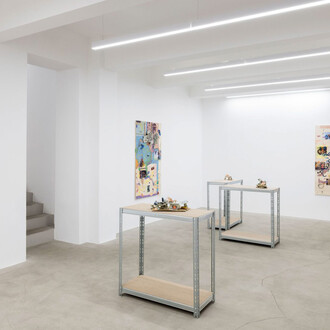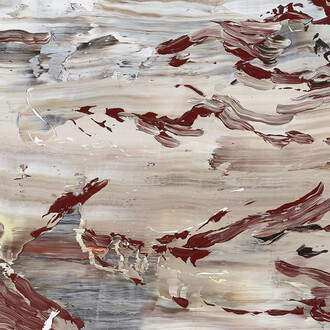Dimora Artica presents Holomovement, a collective exhibition with works from seven emerging artists. The show focuses on the desire to identify a common feeling arising from new interpretations of reality in the scientific and philosophical fields. The title refers to the neologism created by the physicist David Bohm, intended to speculate the structure of the universe as a dynamic hologram. The project connects works made with different techniques, from painting and sculpture to video and installation.
Among the various Theories of Everything developed by physicists, the idea of the universe as a hologram is one of the most fascinating ones in all areas of reality, being full of implications from physics to life, from consciousness to cosmology. In the 1980 essay Wholeness and the Implicate Order, the American physicist David Bohm talks about an implicit order underlying the reality that we perceive, functioning as a hologram in which the general structure is identifiable in every single part. The universe is described by Bohm with the term holomovement, a neologism that combines the principle of undivided totality (everything is one) of the hologram with the idea that everything is in constant movement. In Bohm's hologram each particle is not separate but it is part of a dynamic wholeness that connects it with everything else, in a constant process state similar to the turbulence of a current.
In a holographic vision of the universe, human action also becomes part of larger processes of transformation of reality, not separated from the natural context, entering the cosmic flow as a geophysical force that acts on a large scale. In recent years, the relation between climate change and anthropic activities has brought greater awareness of the substantial unity between man and environment, connected parts of a unique shared system, in which every action has implications even at a considerable distance. The hidden order defined by Bohm and the scheme underlying the manifestations that we read as separate and accidental are connected both to the universe and to human individuality, in the intimate correlation between the particular and the wholeness related to the functioning of this theoretical hologram. In this scenario, the information of the main image is contained in each portion of it. Nature and culture, traditionally divided areas, are actually bound in an interconnected process that involves all the elements of reality in shared flows, vortices and ripples that are constantly moving in the cosmic hologram.
The new sensitivity that is making its way into the contemporary world, characterized by a greater awareness of the close correlation between areas that seemed distant from the philosophical thought of speculative realism, is translating into object-oriented ontology theory and criticism to anthropocentrism, in a horizontal vision whereby all things, both physical and imaginary, are equally founding objects of reality.
In current artistic production, the redefinition of the idea of reality leads into a great sense of compositional freedom, combining apparently heterogeneous references such as the figurative tradition and the digital imaginary, or the mythical sphere merged with globalized capitalism. Man, animals, plants and minerals hybridize in a jagged space, where ancestral cults and symbols are cyclically showing as forms of a psychic imagery shared by all organisms, combining vital needs and survival instinct. A vision of the world becomes complex and fragmented like the overlapping layers of a digital image processed with Photoshop. At the same time, it can become unitary and homogeneous in organizing different informations, materials and narratives in single compositions. Art becomes an epiphany of the hologram that unifies the universe in an interconnected net, showing at the same time the individual interpretation of the present and its particular specificity.
Among the various Theories of Everything developed by physicists, the idea of the universe as a hologram is one of the most fascinating ones in all areas of reality, being full of implications from physics to life, from consciousness to cosmology. In the 1980 essay Wholeness and the Implicate Order, the American physicist David Bohm talks about an implicit order underlying the reality that we perceive, functioning as a hologram in which the general structure is identifiable in every single part. The universe is described by Bohm with the term holomovement, a neologism that combines the principle of undivided totality (everything is one) of the hologram with the idea that everything is in constant movement. In Bohm's hologram each particle is not separate but it is part of a dynamic wholeness that connects it with everything else, in a constant process state similar to the turbulence of a current.
In a holographic vision of the universe, human action also becomes part of larger processes of transformation of reality, not separated from the natural context, entering the cosmic flow as a geophysical force that acts on a large scale. In recent years, the relation between climate change and anthropic activities has brought greater awareness of the substantial unity between man and environment, connected parts of a unique shared system, in which every action has implications even at a considerable distance. The hidden order defined by Bohm and the scheme underlying the manifestations that we read as separate and accidental are connected both to the universe and to human individuality, in the intimate correlation between the particular and the wholeness related to the functioning of this theoretical hologram. In this scenario, the information of the main image is contained in each portion of it. Nature and culture, traditionally divided areas, are actually bound in an interconnected process that involves all the elements of reality in shared flows, vortices and ripples that are constantly moving in the cosmic hologram.
The new sensitivity that is making its way into the contemporary world, characterized by a greater awareness of the close correlation between areas that seemed distant from the philosophical thought of speculative realism, is translating into object-oriented ontology theory and criticism to anthropocentrism, in a horizontal vision whereby all things, both physical and imaginary, are equally founding objects of reality.
In current artistic production, the redefinition of the idea of reality leads into a great sense of compositional freedom, combining apparently heterogeneous references such as the figurative tradition and the digital imaginary, or the mythical sphere merged with globalized capitalism. Man, animals, plants and minerals hybridize in a jagged space, where ancestral cults and symbols are cyclically showing as forms of a psychic imagery shared by all organisms, combining vital needs and survival instinct. A vision of the world becomes complex and fragmented like the overlapping layers of a digital image processed with Photoshop. At the same time, it can become unitary and homogeneous in organizing different informations, materials and narratives in single compositions. Art becomes an epiphany of the hologram that unifies the universe in an interconnected net, showing at the same time the individual interpretation of the present and its particular specificity.
In his works Mattia Barbieri develops a painting with great iconographic and semantic density, in which elements drawn from the history of art and the contemporary collective imagination are remodeled and projected on a single plane, both ideal and concrete. For Holomovement exhibition, Mattia Barbieri presents works from the new series inspired by Giano Bifronte, a mythological figure with two profiles looking to the past and the future creating a frontal figure, a symbol of the present. Like medieval tables, the paintings stand as iconographic mechanisms which, thanks to the arrangement of the elements in the composition, activate an autonomous cosmic order.
With a strong interest in linking different research areas, bn+ BRINANOVARA (Giorgio Brina and Simone Novara) mix different materials with the study of the transition and translation processes of images. The duo works with materials, with the aim of creating elements that stimulate the observation of reality by a new perspective. For the exhibition they present a work from the Unpredictable Ecosystem series, made by layering and removing layers of different colors, where the recognizability of figures drawn from the history of art is linked to portions of the residual image.
In Tania Fiaccadori's research, the concept of persistent images is investigated through the hybridization of western and oriental symbols, passing from fashion design to underground and its subcultures. For Holomovement Tania Fiaccadori presents a small video installation involving a smartphone and an amplifier screen, placed in a symbolic crystal beach. In the video, an underwater environment characterized by a magical atmosphere is inhabited by organic elements that could come from other worlds. Seen through a lens that makes it similar to a hologram, a sea mollusk commonly called Sea angel becomes a mythical divinity that seems to dance in order to communicate its cryptic message.
Valentina Furian's research focuses on the relationship between reality and fiction, staging an imaginary that starts from everyday life and flows into a fantastic dimension. For Holomovement Valentina Furian presents Drago, a video that marks a meeting between two beings that never existed simultaneously. The meeting is revealed by a love gesture that demonstrates the impossible bond between the two elements as an unworkable form of domestication. A plastic veil covers the inert body of a dinosaur. The gesture remains suspended by its transformation into a cyclic movement.
Kamilia Kard's work focuses on building identity in the internet age. For Holomovement Kamilia Kard presents two new sculptures from the Woman as a Temple series, a project that includes 3D printing, virtual reality experiences and editorial products. The Paleolithic past meets an imaginary future in which the ancient sacred representation of the female body is re-proposed as a digital find stored online. Overlapped layers from the 3D prints leaves on the surface traces similar to the growth circles of tree trunks or the stratifications of the Earth's crust.
In Stefano Perrone's paintings, the instability and the saving energy of contemporary men are described through disaggregated figures and objects, dynamically brought back to an order through vectors defining the lines of force of the subject. For Holomovement Stefano Perrone presents recent works, in which the theme of identity is central. The largest work alludes to two-factor authentication, the recognition method required by the latest generation smartphones. In a desert landscape, the calligraphic element of the signature and the perimeter of a mask without its interior are floating to resemble a sort of window on a void.
In his works Andrea Samory questions the boundary between virtuality and reality, outlining hybrid landscapes in which he tries to overcome the traditional difference between synthetic and natural. In works on display, Andrea Samory focuses on the human body in relation to the stereotypical concept of nature and on how familiar images, full of identity and meaning, can become terrifying and disconcerting if released from their idealized context.
















